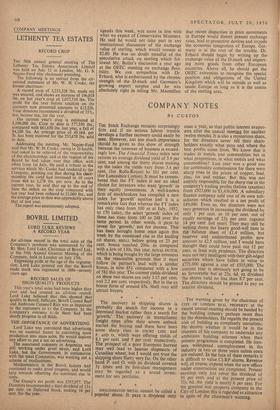COMPANY NOTES
By CUSTOS
THE Stock Exchange remains surprisingly firm and if no serious labour trouble develops a further recovery could easily be seen. However, not too much /importance should be given to this show of strength because the turnover of business is exceed- ingly low. The Financial Times index now returns an average dividend yield of 5.9 per cent, and among the thirty shares making up the index the yields vary from 3.4 per cent. (for Rolls-Royce) to 101 per cent. (for Lancashire Cotton). It must be remem- bered that the FT index is not an ideal choice for investors who want 'growth' in their equity investments. A well-known firm of stockbrokers has compiled a new index for 'growth' equities and it is a remarkable fact that whereas the FT index has only risen from 100 as at July, 1952, to 170 today, the select 'growth' index of these has risen from 100 to 248 over the same period. In other words, it pays to invest for 'growth,' not for income. This has been brought home once again this week by the continued rise in the leading oil shares. SHELL before going ex 25 per cent. bonus touched 206s. as compared with a low of 130s. this year. ROYAL DUTCH, which is being bought by the large investors on the reasonable grounds that it must follow its partner's lead with a similar bonus, is now 851 compared with a low of 58i this year. The current yields dividend on these two shares are only 3.15 per cent. and 2.2 per cent. respectively. But in the ex bonus form of around 85s. Shell may still attract buyers.
The recovery in shipping shares is probably the search for income in a depressed market rather than a search for 'growth.' The recovery in transatlantic freight rates after their severe setback started the buying and there have been some sharp rises in mina LINE and P. AND 0., which were offering yields of 8.1 per cent. and 5 per cent. respectively. The prospect of a poor European harvest may well lead to heavier shipments of Canadian wheat, but I would not trust the shipping share flurry very far. On the other hand P. and 0. with its dividend covered 3-1 times and its first-class management may be regarded as a sound invest- ment for any portfolio. once a year, so that public interest evapor- ates after the annual meeting for another twelve months. It is also a mysterious share, for the directors never tell their share- holders exactly what pays and where the best profits come from. We know that it trades in metals and commodities but in what proportions, in what metals and what commodities? Last year was a good one for commodity commissions for there were sharp rises in the prices of copper, lead, zinc, tin and rubber. But this was not entirely responsible for the sharp rise in the company's trading profits (before taxation) from £923,000 to 11,436,000. A subsidiary finance company sold one of its own sub- sidiaries which resulted in a net profit of £89,000. Even so, the directors were not very generous in increasing the dividend by only 1 per cent. to 10 per cent, out of equity earnings of 23+ per cent. (against 14 per cent last year). They may still be writing down the heavy good-will item in the balance sheet of £1.4 million, but reserves and undistributed profits now amount to £2.5 million, and I would have thought they could have paid out 12 per cent. at least with prudence. The directors were not very intelligent with their gilt-edged securities which have fallen in value to £771,000 against a cost of 035,000. The current year is obviously not going to be SO favourable but at 22s. 6d. ex dividend the shares yield no less than 8.7 per cent. The directors should be pressed to pay an interim dividend.


















































 Previous page
Previous page